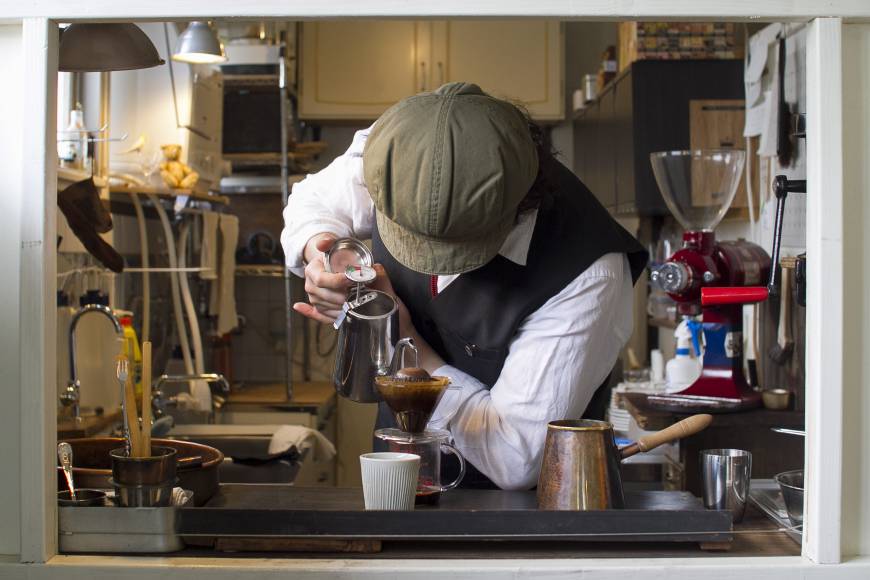Shopping Bag
0
- No products in the cart.

From Tokyo’s classic Café de l’Ambre, where centenarian master Sekiguchi Ichiro still roasts the beans, to sleek specialty coffee shops and retro-cool kissaten (traditional coffee houses), Japan is home to one of the world’s most exciting coffee cultures.
This may come as a surprise to the uninitiated, who assume green tea is the chief caffeinated beverage, but Japan is among the world’s largest importers of coffee. Experts at manual brewing techniques such as siphon and pour over (a.k.a. hand drip), Japanese coffee-making has had a far-reaching effect on the modern movement.
Coffee equipment companies such as Hario and Kalita are the go-to for specialty-coffee enthusiasts around the world. And coffee pioneers including James Freeman, founder of Oakland, Calif.-based Blue Bottle Coffee Company, credit Japan as a major source of inspiration.
Although Japan’s taste for coffee is more recent than Europe’s, cafés were important spaces in Japanese society well before the “Seattle-driven coffee boom,” says Merry White, professor of anthropology at Boston University. In Japan, coffee shops have been flourishing since the late nineteenth century.
White has been sipping coffee and observing daily life in Japanese cafés for more than 40 years. She travels to Japan often, conducting research on various aspects of modern society and culture.
Although she doesn’t remember how the brew tasted, one of White’s earliest Tokyo café experiences during her first trip in the 1960s set the tone for her career in Japanese coffee studies.
“We were asked to take off all our clothes and were painted with blue paint. And I remember thinking at the time, ‘Oh wow! This is the most avant-garde place in the world,’” she recalls.
It evolved from being used as a medicine in its early days (the late 1500s) to “a drink for pleasure” roughly 70 years later when the Dutch, Japan’s sole trading partner during the Edo period (1603 – 1868), started giving it as presents to prostitutes in Nagasaki, White explains.
“Japan’s first coffee shop of record” was founded in 1888: Kachiichakan in Tokyo. By the end of the nineteenth century, Brazil – today’s largest coffee producer – had chosen Japan “as their first targeted, overseas market.”
In 1907, the first coffee chain in the world was established in Tokyo and Osaka: the Paulista group. It was a huge success, White says. Adding that today’s coffee connoisseurs – in Japan as anywhere else – much prefer independent coffee shops to chains, whether local or imported.
“Specialist coffee in Japan was way ahead of the arrival of Starbucks. The coffee house was the number one social space, even more than the bar or the beer hall,” she adds.
“In the 1970s, there were three or four coffee houses per city block in any major Japanese city. There are maybe two now. But still, this is the place you go. It’s almost like breathing… It’s not necessary to be that conscious. Just do it.”
You could spend nearly $20 on an exceptional coffee in Tokyo but options run the gamut across the country. Cold or hot canned coffee is available any time, anywhere via omnipresent vending machines. While convenience stores and homegrown chains such as Doutor Coffee offer inexpensive (and lower-quality) brews.
Until fairly recently, siphon was the most popular method of making coffee in Japan, White says. A French and German invention, it was introduced by the Dutch when they were in residence in the bay of Nagasaki from 1641 until 1853.
At specialty coffeeshops, espresso is becoming increasingly common. But at kissaten (pronounced key-sa-ten), you’re likely to find pour over coffee, each cup individually hand-dripped. Pour over is the reigning style of coffee-making in Japan, White says.
“The spiralling in and spiralling out of the drip. The pinching of the water kettle spout so it exudes just the tiniest stream of water. At a good shop it’s like a ballet. It’s just beautiful to watch,” she adds.
Kissaten offer a unique coffee experience, says Michie Yamamoto, owner of Tandem Coffee in Toronto. Originally from Shizuoka (a city between Tokyo and Nagoya), Yamamoto visits family in Japan regularly. And when she does, it’s the kissaten she favours over contemporary cafés.
You can usually identify a kissaten by its retro stylings – the décor and furnishings commonly date back to the 1950s or 60s, she says. They have a comfortable, nostalgic vibe and a slower pace than modern coffee shops. Sometimes, the owner-master will be wearing a tuxedo complete with a bow tie.
“The atmosphere is so amazing. They have many regulars from a long time ago. That’s part of their morning (ritual). Every morning they go and chat and have a coffee and maybe smoke some cigarettes,” Yamamoto says.
“Most of them make (hand) drip coffee. That’s their traditional style, especially the older shops. Last time when we went to Asakusa in Tokyo, we went to quite a few kissaten but none of them had espresso machines.”
Coffee masters in Japan historically resisted the espresso machine, White explains. Coffee produced with a machine wasn’t considered a handmade product; the device interfered between the coffee and its maker.
Hand drip is the main offering of a kissaten, but many also serve morning set: an inexpensive light breakfast that comes with your first cup of coffee. Both Yamamoto and White recommend visiting Nagoya to experience its tasty take on the breakfast.
“There are extraordinary kinds of Nagoya morning set tourism,” White says. “So do something a little off the track and find out how people have made coffee not just Japanese but really regional and local… in Japan.”
High technology is a wonderful thing, Yamamoto says. But the time-honoured tradition on display in kissaten offers visitors a fascinating coffee experience that is vastly different from any available in Canada.
Within one of the most refined and trend-setting coffee cultures in the world, kissaten are spaces where attention to customer experience and craft are paramount.
Free Shipping On All Orders $200+ |
